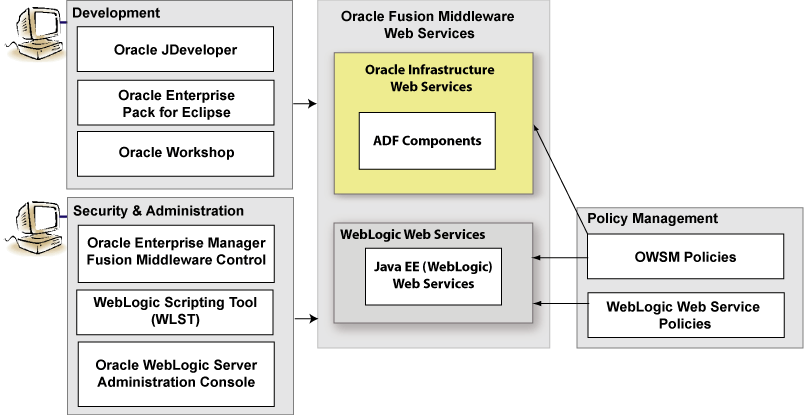1 Introducing Oracle Infrastructure Web Services
This chapter introduces Oracle Infrastructure Web services and describes the standards supported.
This chapter includes the following sections:
Overview of Oracle Infrastructure Web Services
In Oracle Fusion Middleware 12c, there are two categories of Web services to support the development, security, and administration of the following types of Web services:
-
Oracle Infrastructure Web services—ADF services
-
Java EE (WebLogic) Web services)
The following figure illustrates the two Web services categories. Oracle Infrastructure Web services are highlighted (in yellow) in the figure.
Figure 1-1 Web Services in Oracle Fusion Middleware 12c

Description of "Figure 1-1 Web Services in Oracle Fusion Middleware 12c"
Note:
For more information about the full set of components shown in the figure, including the development; security and administration; and policy management tools, see Understanding Web Services.
This chapter describes concepts for developing Oracle Infrastructure Web services. For more information about Java EE Web services, see Understanding WebLogic Web Services for Oracle WebLogic Server.
Types of Oracle Infrastructure Web Services and Clients
Table 1-1 summarizes the types of Oracle Infrastructure Web services supported in Oracle Fusion Middleware 12c.
Table 1-1 Oracle Infrastructure Web Services
| Web Service | Description |
|---|---|
|
ADF Business Components |
ADF Business Components simplify the development, delivery, and customization of business applications for the Java EE platform by providing a library of reusable components and supporting design time facilities in Oracle JDeveloper. Using ADF Business Components, developers are not required to write the application infrastructure code required by the typical Java EE application to perform the following tasks:
Additionally, Oracle JDeveloper facilities expose ADF Business Component application modules that encapsulate built-in data manipulation operations and custom methods as Web services so that a service-enabled application module can be consumed across modules of the deploy Fusion Web application. For more information, see "Integrating Service-Enabled Application Modules" in Developing Fusion Web Applications with Oracle Application Development Framework. |
Table 1-2 summarizes the types of Oracle Infrastructure Web service clients supported in Oracle Fusion Middleware 12c.
Table 1-2 Oracle Infrastructure Web Service Clients
| Web Service Client | Description |
|---|---|
|
ADF Web applications |
ADF Web applications can invoke a service, such as a WebLogic Web service or a service-enabled ADF application module. For more information, see Oracle Fusion Middleware Developer's Guide for Oracle SOA Suite. In addition, ADF Web applications can work with Web services in the user interface using a Web service data control. For more information about generating service-enabled application modules, calling a Web service from an ADF application module, or creating Web service data controls, see Developing Fusion Web Applications with Oracle Application Development Framework. |
Supported Standards
The following table summarizes the Oracle Infrastructure Web service specifications that are part of the Oracle implementation, organized by high-level feature.
Oracle considers interoperability of Web services platforms to be more important than providing support for all possible edge cases of the Web services specifications. Oracle complies with the following specifications from the Web Services Interoperability Organization and considers them to be the baseline for Web services interoperability:
-
Basic Profile 1.1 and 1.0:
http://www.ws-i.org/Profiles/BasicProfile-1.1-2004-08-24.html -
Basic Security Profile 1.0:
http://www.ws-i.org/Profiles/BasicSecurityProfile-1.0.html -
WS-I Attachments Profile 1.0:
http://www.ws-i.org/Profiles/AttachmentsProfile-1.0.html
Note:
For more information about Oracle Infrastructure Web service security standards, see "Web Services Security Standards" in Understanding Oracle Web Services Manager.
Table 1-3 Specifications Supported by Oracle Infrastructure Web Services
| Feature | Specification |
|---|---|
|
Programming model (based on metadata annotations) and runtime architecture |
Web Services Metadata Exchange (WS-MetadataExchange) 1.1—Part of the WS-Federation roadmap which allows retrieval of metadata about a Web service endpoint. For more information, see Web Services Metadata Exchange (WS-MetadataExchange) specification at |
|
Web service description |
|
|
Data exchange between Web service and requesting client |
|
|
Security |
|
|
Reliable communication |
|
|
Atomic transactions |
Web Services Atomic Transaction—Defines the Atomic Transaction coordination type that is to be used with the extensible coordination framework described in the Web Services Coordination specification. The WS-AtomicTransaction and WS-Coordination specifications define an extensible framework for coordinating distributed activities among a set of participants. For more information, see: |
|
Optimizing XML transmission |
|
|
Advertisement (registration and discovery) |
|
Related Documentation
The following table summarizes the documentation that is related to Oracle Infrastructure Web services development, security, and administration.
Table 1-4 Related Documentation
| Document | Description |
|---|---|
|
Provides an introduction to Web services for Oracle Fusion Middleware 12c. |
|
|
Understanding WebLogic Web Services for Oracle WebLogic Server |
Provides an introduction to WebLogic Web Services (Java EE). |
|
Introduces Oracle Web Services Manager (OWSM) used for Web services policy attachment and management. |
|
|
Describes how to secure and administer Web services. |
|
|
Securing Web Services and Managing Policies with Oracle Web Services Manager |
Describes how to secure Web services using OWSM policies. This document also describes how to create and manage OWSM policies. |
|
Describes how to build custom policy assertions for OWSM. |
|
|
Interoperability Solutions Guide for Oracle Web Services Manager |
Describes how to implement the most common OWSM interoperability scenarios. |
|
Developing Fusion Web Applications with Oracle Application Development Framework |
Describes how to develop ADF components. |
|
"Developing and Securing Web Services" in Developing Applications with Oracle JDeveloper |
Describes how to develop Web services and attach policies using Oracle JDeveloper. |
|
Explains how to use Workshop to write and manage source code and design with sophisticated visual tools and Java frameworks. |